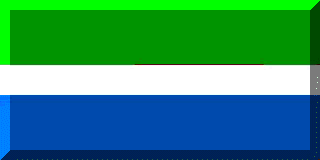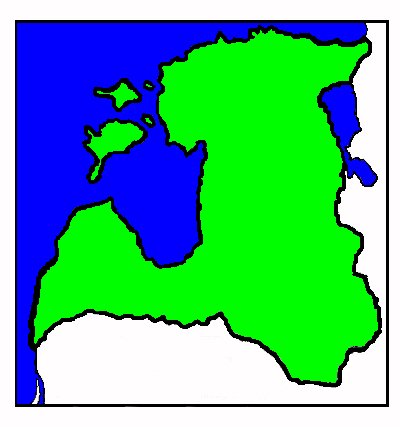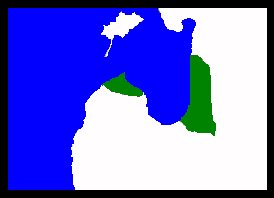
| |

 In this case it could be said that there are, in fact, two Livonias.
Historical Livonia (shown in light green in the picture to the left), was a province of
both the pope and of the Germans. It was made up of what today are Latvia and Estonia.
This Livonia was composed of small feudal states headed by various religious leaders and
the Teutonic Knights. It came into existence during the 12th and 13th Centuries and lasted
until the middle of the 16th Century. It should not be confused with the term Livland
which was sometimes used to describe Vidzeme, the northeastern part of Latvia. As
far as these pages are concerned, however, Livonia is the term chosen to designate
the region which the Livonians have inhabited in the past and still inhabit today (shown
in dark green in the picture to the right). Towards the end of the 19th Century, the last
Livonians living on the In this case it could be said that there are, in fact, two Livonias.
Historical Livonia (shown in light green in the picture to the left), was a province of
both the pope and of the Germans. It was made up of what today are Latvia and Estonia.
This Livonia was composed of small feudal states headed by various religious leaders and
the Teutonic Knights. It came into existence during the 12th and 13th Centuries and lasted
until the middle of the 16th Century. It should not be confused with the term Livland
which was sometimes used to describe Vidzeme, the northeastern part of Latvia. As
far as these pages are concerned, however, Livonia is the term chosen to designate
the region which the Livonians have inhabited in the past and still inhabit today (shown
in dark green in the picture to the right). Towards the end of the 19th Century, the last
Livonians living on the eastern side of the Gulf of Riga died. At the beginning of the 20th Century,
the remaining Livonians lived in small towns in the extreme northwestern part of Latvia.
Less than a year after the restoration of Latvian independence, the Latvian government
created a special cultural territory for the Livonians. On February 4, 1991, the Latvian
Council of Ministers approved the creation of Livõd
Rãnda, which approximately means "Livonian
Coast," in Livonian. This territory is said to include all of the pre-war Livonian
towns. It's an approximately 80 km long strip of land on the extreme northwestern shore of
Latvia, and is inhabited by approximately 1,700 people. eastern side of the Gulf of Riga died. At the beginning of the 20th Century,
the remaining Livonians lived in small towns in the extreme northwestern part of Latvia.
Less than a year after the restoration of Latvian independence, the Latvian government
created a special cultural territory for the Livonians. On February 4, 1991, the Latvian
Council of Ministers approved the creation of Livõd
Rãnda, which approximately means "Livonian
Coast," in Livonian. This territory is said to include all of the pre-war Livonian
towns. It's an approximately 80 km long strip of land on the extreme northwestern shore of
Latvia, and is inhabited by approximately 1,700 people.
|